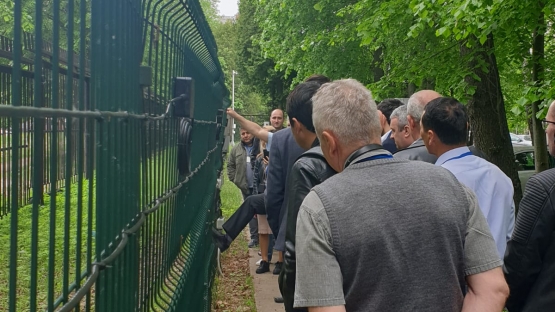The IAEA held its first bilingual regional practical training course on security of radioactive material under regulatory control last month at the Rosatom Technical Academy in Obninsk, the Russian Federation.
The 13-17 May course was taught in English and Russian with simultaneous interpretation, enabling the 24 radioactive material users and regulators from Albania, Azerbaijan, Belarus, Bulgaria, France, Kazakhstan, Kyrgyzstan, Republic of Moldova, Romania, the Russian Federation, Slovenia and Uzbekistan taking part in the course to share experiences and insights across language barriers.
“The course was an opportunity for participants to identify positive practices amongst the international community,” said Craig Thompson, Security Advisor in the Nuclear Security Division of the Canadian Nuclear Safety Commission, a course instructor. “The course allowed unique dialogue by encouraging discussion among both English- and Russian-language participants with non-stop simultaneous interpretation.”
The course, which will be part of the IAEA’s standard training material, used a curriculum based on a forthcoming update of the IAEA Nuclear Security Series Implementing Guide Security of Radioactive Sources (IAEA Nuclear Security Series No. 11).
The course featured a comprehensive overview of radioactive source security principles, hands-on sessions on the development of physical protection systems and measures for radioactive material in use and storage, as well as tandem tabletop and outdoor field exercises.
At the outdoor training facility at the Rosatom Technical Academy, participants pretending to be adversaries triggered alarms and circumvented cameras in an attempt to reach hypothetical radioactive material in an exercise that evaluated physical protection systems and measures.
“By combining theory and practice, the course enabled me to learn how to apply the key provisions in the IAEA guidance on security of radioactive material and associated facilities,” said Natalya Romanova, Researcher at the Nuclear Safety Laboratory at the Institute of Nuclear Physics in Kazakhstan’s Ministry of Energy.
Participant William Bouclier, Responsible for Missions at the French Institute for Radiological Protection and Nuclear Safety’s Nuclear Defense and Security Expertise Divsion, added: “The experience gained will be very useful to assess physical protection systems established by licensees to comply with national regulatory requirements.”
Marina Labyntseva, Deputy Director for International Affairs at Rosatom’s Global Nuclear Safety and Security Institute, summarized at the closing ceremony that during the training the participants had designed a strategy to protect radioactive material at a hypothetical facility, which included a calibration laboratory, interim storage, and national repository of disused radioactive material. Through this exercise the participants translated Nuclear Security Series No. 11 into a facility-specific tangible plan, based on graded approach and threat assessments.
The course also focused on insider threats, which are posed by adversaries with access, authority and knowledge of a facility. Such threats can challenge the detection, delay and response functions of any protection system.
The course was based on a curriculum used for the first time in December 2018 in a Russian-language course, also held in Obninsk.
The course is part of capacity building efforts – offered on request – that form a crucial part of the IAEA’s nuclear security work, said Raja Abdul Aziz Raja Adnan, Director of IAEA Division of Nuclear Security.
“Physical protection systems and measures are only as good as the humans that maintain and enforce them,” he said. “The human elements of nuclear security, including measures against insider threat and a robust nuclear security culture, should not be overlooked.”
The course was financed by the Russian Federation through contributions to the IAEA’s Nuclear Security Fund. The Russian Federation is also financing and supporting an IAEA effort to develop a new training course on design and evaluation of physical protection systems for radioactive material and associated facilities. A pilot course will be launched in November 2019 in Obninsk.






